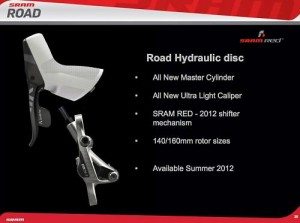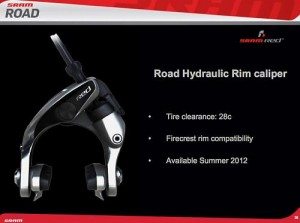 Some information has been released from SRAM about the chatter their latest leak has generated. A lot of forums have been abuzz with the new offerings and what this will mean to road and cyclocross, frame design and future compatibility. The following quotes have been taken from Velonews.com who ran the article, and my take on them follows:
Some information has been released from SRAM about the chatter their latest leak has generated. A lot of forums have been abuzz with the new offerings and what this will mean to road and cyclocross, frame design and future compatibility. The following quotes have been taken from Velonews.com who ran the article, and my take on them follows:
On the lever shape, which some have commented is “tall and blocky:”
“SRAM road product manager Bill Keith insists that the hydraulic lever shown in these images is not final, but given the mid-summer release timeframe we can assume it is quite close.”
It looks like a pretty final design to me. In all reality, I don't see much other way they can get away with stuffing the master cylinder into the lever body, considering the DoubleTap mechanism can't really be disturbed within the body of the shifter as it is. Either way, it appears to be a much more blocky version of the svelte Campagnolo 11 speed levers we've come to know and love.
On lever weight:
“SRAM’s Charles Becker claimed that the new lever would remain at a competitive weight during the presentation last week. “It’ll be a bit heavier, but not as much as you think,” he said. We have no further information on weights at this time.”
Mountain bike disc brakes are approaching epically light territory, and I would expect these would be no exception. However, while they are likely to be light, swapping cables and housing for hydraulic fluid and line, as well as increasing the amount of weight in the shifter body, adding a rotor, heavier hubs and hardware will likely add several hundred grams in reality.
“‘This isn’t just a mountain brake stuck on a road bike,' insisted Becker. “It’s designed specifically around 700c use.” It doesn’t even carry the Avid brand name, but rather fits the style and graphics of the new Red group.”
“From that we can infer that the whole system will be slightly less powerful than SRAM’s top mountain brakes, with a greater focus on improved modulation. Such a change becomes vital with a road disc system due to drastically decreased tire contact patch and subsequent ease of overpowering the tire and locking up a wheel.”
When it comes down to it, most mountain bikes with larger tires (as is chic these days) are pretty close to “700c” diameter anyway. I don't see there being much difference.
More important is the second point since the tire contact patch is far smaller. In all honesty, how many of you CAN'T lock up your brakes right now? If you look at the current braking system, the longest lever arm for braking is at the edge of the rim: current brakes are basically huge discs with mechanical calipers. What's severely lacking is braking power in the wet, particularly with carbon rims; right now I don't see carbon rim development to be at its terminus, so I would expect braking surface improvements to solve these issues in the future.
“As of now, the caliper will use a regular post mount, but Becker hinted that SRAM is working with frame manufacturers to develop a road-specific mount. Don’t wait for it though — any changes on that front are at least a year or two away.”
Ahhh, joy. Yet ANOTHER standard for the consumer to “swallow.” It's bad enough we have about 8 different bottom bracket standards and half a dozen headset variations, but now we'll have a “road specific disc mount” standard? Sounds like a great marketing ploy. Post mount has worked on mountain bikes for years….why wouldn't it work on the road?

“While the RT8 essentially works by pushing a wedge in between two levers, SRAM’s offering is a single-pivot brake that functions much like its mechanical brethren. It even has a quick-release lever and, though I couldn’t get anyone at SRAM to confirm it last week, appears to have a barrel adjuster as well. As the slides say, tires up to 28c will fit without issue, and the power curves are designed around wide rims like Zipp’s Firecrest models.”
Now this is somewhat unclear. It seems they are saying the hydraulic rim caliper will be designed for wide rims specifically. Does that mean there will be a performance drop off for those of use (the majority I'm going to propose) who use standard rims? Not everyone has gone to 23mm or larger rims, and I'd be very curious to know how these will work with older models.
Update 3/31/12: You can check out Colnago's C59 Disc with formula hydraulics right here.
Thoughts? Comments?
2 thoughts on “SRAM Red Hydraulic Updates”
Comments are closed.